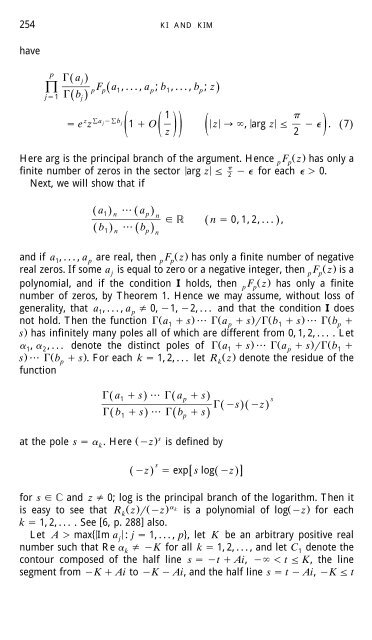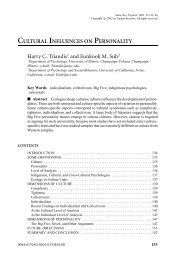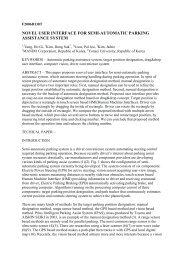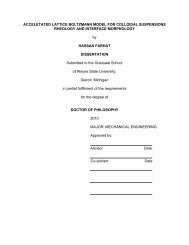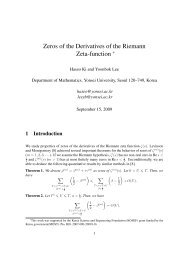On the Zeros of Some Generalized Hypergeometric Functions
On the Zeros of Some Generalized Hypergeometric Functions
On the Zeros of Some Generalized Hypergeometric Functions
You also want an ePaper? Increase the reach of your titles
YUMPU automatically turns print PDFs into web optimized ePapers that Google loves.
254<br />
have<br />
p Ž a .<br />
KI AND KIM<br />
j<br />
Ł p p 1 p 1 p<br />
j1 Ž bj<br />
.<br />
F Ž a ,...,a ; b ,...,b ; z.<br />
ž ž / /<br />
ž /<br />
1 <br />
z Ýa jÝb ez j 1 O z, arg z . Ž 7.<br />
z 2<br />
Here arg is <strong>the</strong> principal branch <strong>of</strong> <strong>the</strong> argument. Hence F Ž z. p p has only a<br />
<br />
finite number <strong>of</strong> zeros in <strong>the</strong> sector arg z 2 for each 0.<br />
Next, we will show that if<br />
Ž a1. n Ž ap<br />
. n<br />
Ž n 0,1,2,... . ,<br />
b b<br />
Ž . Ž .<br />
1 n p n<br />
and if a ,...,a are real, <strong>the</strong>n F Ž z. 1 p p p has only a finite number <strong>of</strong> negative<br />
real zeros. If some a is equal to zero or a negative integer, <strong>the</strong>n F Ž z. j p p is a<br />
polynomial, and if <strong>the</strong> condition I holds, <strong>the</strong>n F Ž z. p p has only a finite<br />
number <strong>of</strong> zeros, by Theorem 1. Hence we may assume, without loss <strong>of</strong><br />
generality, that a 1,...,a p 0, 1, 2, . . . and that <strong>the</strong> condition I does<br />
not hold. Then <strong>the</strong> function Ž a s. Ž a s. Ž b s. Ž 1 p 1 bp <br />
s. has infinitely many poles all <strong>of</strong> which are different from 0, 1, 2, . . . . Let<br />
, , . . . denote <strong>the</strong> distinct poles <strong>of</strong> Ž a s. Ž a s. Ž 1 2 1 p b1 <br />
s. Ž b s . . For each k 1, 2, . . . let R Ž z. p k denote <strong>the</strong> residue <strong>of</strong> <strong>the</strong><br />
function<br />
Ž a s. Ž a s.<br />
Ž s.Ž z.<br />
b s b s<br />
1 p s<br />
Ž . Ž .<br />
1 p<br />
Ž . s<br />
at <strong>the</strong> pole s . Here z is defined by<br />
k<br />
s<br />
z exp s log z<br />
Ž . Ž .<br />
for s and z 0; log is <strong>the</strong> principal branch <strong>of</strong> <strong>the</strong> logarithm. Then it<br />
Ž . Ž . is easy to see that R z z k is a polynomial <strong>of</strong> logŽ z. k<br />
for each<br />
k 1, 2, . . . . See 6, p. 288 also.<br />
Let A max Ima : j 1,..., p 4<br />
j<br />
, let K be an arbitrary positive real<br />
number such that Re k K for all k 1, 2, . . . , and let C1 denote <strong>the</strong><br />
contour composed <strong>of</strong> <strong>the</strong> half line s t Ai, t K, <strong>the</strong> line<br />
segment from K Ai to K Ai, and <strong>the</strong> half line s t Ai, K t


